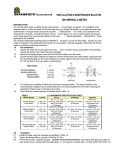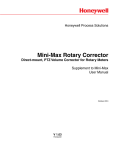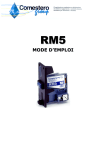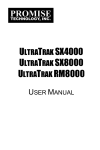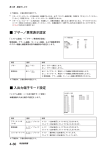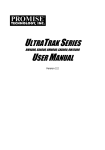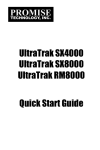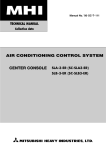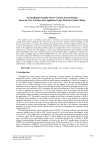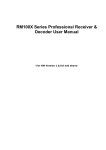Download Auditing energy usage for households
Transcript
g n i t i d u A r o f e g a s u y g r e n e s d l o h e s u ho A DDC Project Publication by Centre for Environment, Technology and Development, Malaysia (CETDEM) 17 Jalan SS2/53, 47300 Petaling Jaya, Selangor Tel: 03-78757767 Fax: 03-78754039 URL: www.cetdem.org.my with funding from Danish International Development Assistance (DANIDA) Auditing Energy Usage for Households Energy consumption can be controlled and reduced by monitoring and adjusting the equipment operations and analyzing which equipment consumes most power. By making households more energy efficient, the negative impacts on the environment can be reduced. Energy efficiency at home involves monitoring household operations and making adjustments. The first step is to audit energy consumption for every household equipment, and how it is operated. A blank energy audit form is provided at the end of this document to help you start this process. Step 1 • • Obtain equipment power rating Analyze and log the operation time for at least a month Below is a list of some common household items and their corresponding average power rating. Your electrical items may have different power ratings. Table A: Average Household Item Power Rating Appliance Description Watts Air Conditioning Units Air Cooled Split Unit (1.0 hp) 750 Air Cooled Split Unit (1.5 hp) 1000 Air Cooled Split Unit (2.0 hp) 1200 Water Heaters Instant Water Heater 1000 Storage Water Heater (55 l) 3000 Kitchen Appliances Refrigerator Microwave Oven Hob Extractor Fan Electric Kettle Coffee Maker Food Processor/ Blender Toaster (2 Slice) 170-550 1050-2100 144 1200-2400 1200 400 1200 Rice Cooker 260-1550 Electric Oven 600-1000 Electric Whisk/Mixer 120 Cooker - Small Ring (Electric) 1250 Cooker - Large Ring (Electric) 2100 Hygiene Hair Dryer 750-1500 Hair Curler 750 Electric Toothbrush A DDC Project publication by CETDEM Version 2 6 1 General Household Clock Radio Electric Iron (dry) Electric Iron (steam) Washing Machine (top loading) Washing Machine (front loading) Electric Clothes Dryer Vacuum Cleaner Ceiling fan 5 950-1100 1200-1450 210-450 1150-1800 5750 800-1600 71-95 Entertainment/Communications Television 80-175 Satellite System with auto orientation/remote control 45 Video Recorder (VCR) 30 CD Player, DVD Player 30 AC Powered Stereo (average volume) 55 AC Powered Stereo, surround sound system 500 Step 2 Then evaluate the existing equipment's power consumption such as if the equipment is put on standby. More generally, it is noting down the way your home is operated. • • • Identify equipment(s) that consume a lot of power Identify equipment(s) that is normally put on standby power Analyze how the house is operated and categorise equipment or their usage pattern as “required” and “in excess” Step 3 The third step is to come up with a plan on how power consumption in the home can be reduced. The plan can be put into action immediately or gradually to complement your lifestyle. There are currently no standards to adhere to. It is really up to you to categorise what is needed and what is in excess. • • Create a plan to reduce energy consumption based on your categorisation Implement the plan gradually or immediately Step 4 The fourth step is a post mortem of the implemented plan. • • Record the new energy consumption profile of the house Reanalyze the plan and make amendments as necessary At this point, you should be able to witness the reduction of energy consumption in your home. A DDC Project publication by CETDEM Version 2 2 Here is an example of how the audit form can be used: Utilities and petrol bill. Crosscheck against calculated figures Sample Energy Audit Form Date of Audit House Owner Address House Type No. of People Ave Monthly Bill 23rd Nov 2001 Sto’et Jinggo 5, East 4th Street, Chow YF Park, 90210 Kuala Lumpur Double Storey Link House 2 Adults 3 Children Electricity RM 135.00 Gas RM 19.00 Item Kitchen Obtain rating from Refrigerator equipment label or user manual Kettle Rice Cooker Microwave Oven Oven (Elect./Gas) Stove Toaster Blender Dishwasher Cooker Hood Bathroom/Laundry Water Heater Washing Machine Total usage of Iron this equipment Hair Dryer or a no of eq. in hrs per month Clothes Dryer Living Rm/Bedroom Fan Television Total energy usage per Radio type of equipment per month Computer x # hrs of usage) Air Conditioner (kw (1.0hp) Air Conditioner (1.5hp) Lighting Incandescent Lamps (60W) Incandescent Lamps (80W) Incandescent Lamps (100W) Flourescent Lamps (18W) Flourescent Lamps (32W) Compact Flour. Lamps (5W) Compact Flour. Lamps (11W) Compact Flour. Lamps (15W) Others Vacuum Cleaner No. Rating Age of Equipment Watts Years Type of Energy Page 1/2 Petrol RM 300.00 Usage (ave 30d) Electric/Gas hrs/month Total Energy Used (per mth) kwh 1 1 1 1 1 1 1 1 0 1 300 0 650 800 2200 NA 1000 400 0 300 5 5 5 3 2 5 5 3 0 5 Electric Gas Electric Electric Electric Gas Electric Electric Electric Electric 432 30 30 2 2 30 5 1 0 30 129.6 0 19.5 1.6 4.4 0.5 cylinder 5.0 0.4 0 9.0 1 1 1 1 0 2700 2200 1000 300 0 1 5 5 3 0 Electric Electric Electric Electric Electric 30 45 15 8 0 81.0 99.0 15.0 2.4 0 6 1 1 1 0 1 45 60 250 120 0 1000 5 7 7 2 0 1 Electric Electric Electric Electric Electric Electric 300 90 6 30 0 60 13.5 5.4 1.5 3.6 0 60 0 0 0 2 0 0 0 18 0 0 0 0.3 Electric Electric Electric Electric 0 0 0 240 0 0 0 4.3 6 32 0.3 Electric 900 28.8 0 6 0 0 11 0 0 0.3 0 Electric Electric Electric 0 450 0 0 5.0 0 1 300 4 Electric 8 2.4 Total energy usage per month (add all figures) A DDC Project publication by CETDEM Version 2 Total (kwh) 491.4 3 Current electricity charges by TNB Calculate Electricity Cost Usage Cost Breakdown Unit Cost Calculated Units Calculated Cost Up to 200 kwh RM 0.218 200 43.60 200 to 800 kwh RM 0.256 291.4 74.60 No. Engine Capacity (cc) Page 2/2 >800kwh Crosscheck against electricity bill RM 0.278 0 0 118.20 Total Calculated Cost Transportation Item Vehicle 1 Work Leisure Vehicle 2 Work Leisure Age of Vehicle Fuel Type Mileage (km) Total Consp (L) Total amount of fuel used can be obtained from fill up receipts or from the amount paid for fuel divided by price per litre (RM 1.42) Analysis • Most power consuming equipment (combination of rating & operation) o Refrigerator, Water Heater, Washing Machine, Air Conditioner • Equipment are fairly new • Did not check energy rating of equipment when buying the equipment Proposed plan for implementation • Use cold rinse for washing machine • Use water heater only on really cold days, and take quick showers • Use air conditioner on really hot nights and set a higher temperature (can sleep without blanket), and put it on timer to turn off after 1 hr Implementation (after 1 month) • Manage to reduce operating hours for the following equipment o Water heater to 7.5 hrs o Air conditioner to 30 hrs Post Mortem • Average electricity bill has been reduced by RM 12.00 (saved 50 kwh x RM 0.257) • Reduction of 50 kg CO2 equivalent released into the atmosphere (for each kwh of electricity saved, 1 kg CO2 is not released into the atmosphere) • Will try to not use hot water heater and air conditioner at all • Will change to more energy efficient refrigerator in the future • Switch off standby powered equipment (Consumes 10% more power) A DDC Project publication by CETDEM Version 2 4 Audit your own home with this form! Energy Audit Form Date of Audit House Owner Address House Type No. of People Ave Monthly Bill Household Monthly Income (please circle) Item Page 1/2 Electricity Less than RM1000 No. Kitchen Refrigerator Kettle Rice Cooker Microwave Oven Oven (Elect./Gas) Stove Toaster Blender Dishwasher Cooker Hood Bathroom/Laundry Water Heater Washing Machine Iron Hair Dryer Clothes Dryer Living Rm/Bedroom Fan Television Radio Computer Air Conditioner (1.0hp) Air Conditioner (1.5hp) Lighting Gas Petrol RM1000 – RM2500 RM2501 – RM5000 RM5001 – RM8000 More than RM8000 Rating Age of Equipment Type of Energy Usage (ave. 30d) Watts Years Electric/Gas hrs/month Total Energy Used (per mth) kwh 432* Incandescent Lamps (60W) Incandescent Lamps (80W) Incandescent Lamps (100W) Flourescent Lamps (18W) Flourescent Lamps (32W) Compact Flour. Lamps (5W) Compact Flour. Lamps (11W) Compact Flour. Lamps (15W) Others Vacuum Cleaner Total (kwh) * This figure is 65% of 720 hours (24hours x 30 days). This is because the fridge compressor is not working all the 24hours a day. A DDC Project publication by CETDEM Version 2 5 Page 2/2 Calculate Electricity Cost Usage Cost Breakdown Unit Cost Calculated Units Calculated Cost Up to 200 kwh RM 0.218 200 to 800 kwh RM 0.256 >800kwh RM 0.278 Total Calculated Cost Transportation Item No. Engine Capacity (cc) Age of Vehicle Fuel Type Mileage (km) Total Consp (L) Vehicle 1 Work Leisure Vehicle 2 Work Leisure Notes • • • The estimated power consumption for equipment can be obtained from Table A if the equipment rating or the user manual is not available. Analyze energy usage space by space. It is much appreciated if you are able to forward a copy of your home's audit form to us. Your form will assist us in setting up a profile of energy usage in Malaysia. Rest assured, all information in the profile will be anonymous. You may send the form to us via: Post: 17, Jalan SS2/53, 47300 Petaling Jaya, Selangor Email: [email protected] Fax: 03-78754039 A DDC Project publication by CETDEM Version 2 6







